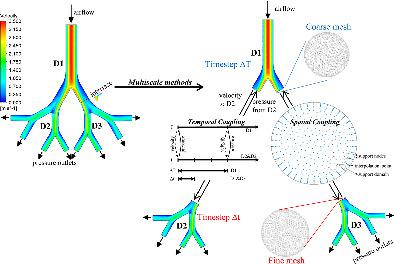当前位置:
X-MOL 学术
›
Int. J. Numer. Methods Fluids
›
论文详情
Our official English website, www.x-mol.net, welcomes your
feedback! (Note: you will need to create a separate account there.)
A multiscale modeling method incorporating spatial coupling and temporal coupling into transient simulations of the human airways
International Journal for Numerical Methods in Fluids ( IF 1.7 ) Pub Date : 2021-05-24 , DOI: 10.1002/fld.5015 Zhenya Fan 1 , David Holmes 1 , Emilie Sauret 1 , Mohammad S. Islam 2 , Suvash C. Saha 2 , Zoran Ristovski 3 , Yuan Tong Gu 1
International Journal for Numerical Methods in Fluids ( IF 1.7 ) Pub Date : 2021-05-24 , DOI: 10.1002/fld.5015 Zhenya Fan 1 , David Holmes 1 , Emilie Sauret 1 , Mohammad S. Islam 2 , Suvash C. Saha 2 , Zoran Ristovski 3 , Yuan Tong Gu 1
Affiliation

|
In this article, a novel multiscale modeling method is proposed for transient computational fluid dynamics (CFD) simulations of the human airways. The developed method is the first attempt to incorporate spatial coupling and temporal coupling into transient human airway simulations, aiming to improve the flexibility and the efficiency of these simulations. In this method, domain decomposition was used to separate the complex airway model into different scaled domains. Each scaled domain could adopt a suitable mesh and timestep, as necessary: the coarse mesh and large timestep were employed in the macro regions to reduce the computational cost, while the fine mesh and small timestep were used in micro regions to maintain the simulation accuracy. The radial point interpolation method was used to couple data between the coarse mesh and the fine mesh. The continuous micro solution–intermittent temporal coupling method was applied to bridge different timesteps. The developed method was benchmarked using a well-studied four-generation symmetric airway model under realistic normal breath conditions. The accuracy and efficiency of the method were verified separately in the inhalation phase and the exhalation phase. Similar airflow behavior to previous studies was observed from the multiscale airway model. The developed multiscale method has the potential to improve the flexibility and efficiency of transient human airway simulations without sacrificing accuracy.
中文翻译:

一种将空间耦合和时间耦合纳入人体呼吸道瞬态模拟的多尺度建模方法
在本文中,提出了一种新的多尺度建模方法,用于人体呼吸道的瞬态计算流体动力学 (CFD) 模拟。所开发的方法是首次尝试将空间耦合和时间耦合纳入瞬态人体气道模拟,旨在提高这些模拟的灵活性和效率。在这种方法中,域分解被用来将复杂的气道模型分成不同的缩放域。每个缩放域可以根据需要采用合适的网格和时间步长:宏观区域采用粗网格和大时间步以降低计算成本,而微观区域采用细网格和小时间步,以保持模拟精度。粗网格和细网格之间采用径向点插值方法耦合数据。应用连续微解-间歇时间耦合方法来桥接不同的时间步长。在现实的正常呼吸条件下,使用经过充分研究的四代对称气道模型对开发的方法进行了基准测试。在吸入阶段和呼气阶段分别验证了该方法的准确性和效率。从多尺度气道模型中观察到与先前研究类似的气流行为。开发的多尺度方法有可能在不牺牲准确性的情况下提高瞬态人体气道模拟的灵活性和效率。在现实的正常呼吸条件下,使用经过充分研究的四代对称气道模型对开发的方法进行了基准测试。在吸入阶段和呼气阶段分别验证了该方法的准确性和效率。从多尺度气道模型中观察到与先前研究类似的气流行为。开发的多尺度方法有可能在不牺牲准确性的情况下提高瞬态人体气道模拟的灵活性和效率。在真实的正常呼吸条件下,使用经过充分研究的四代对称气道模型对开发的方法进行了基准测试。在吸入阶段和呼气阶段分别验证了该方法的准确性和效率。从多尺度气道模型中观察到与先前研究类似的气流行为。开发的多尺度方法有可能在不牺牲准确性的情况下提高瞬态人体气道模拟的灵活性和效率。
更新日期:2021-05-24
中文翻译:

一种将空间耦合和时间耦合纳入人体呼吸道瞬态模拟的多尺度建模方法
在本文中,提出了一种新的多尺度建模方法,用于人体呼吸道的瞬态计算流体动力学 (CFD) 模拟。所开发的方法是首次尝试将空间耦合和时间耦合纳入瞬态人体气道模拟,旨在提高这些模拟的灵活性和效率。在这种方法中,域分解被用来将复杂的气道模型分成不同的缩放域。每个缩放域可以根据需要采用合适的网格和时间步长:宏观区域采用粗网格和大时间步以降低计算成本,而微观区域采用细网格和小时间步,以保持模拟精度。粗网格和细网格之间采用径向点插值方法耦合数据。应用连续微解-间歇时间耦合方法来桥接不同的时间步长。在现实的正常呼吸条件下,使用经过充分研究的四代对称气道模型对开发的方法进行了基准测试。在吸入阶段和呼气阶段分别验证了该方法的准确性和效率。从多尺度气道模型中观察到与先前研究类似的气流行为。开发的多尺度方法有可能在不牺牲准确性的情况下提高瞬态人体气道模拟的灵活性和效率。在现实的正常呼吸条件下,使用经过充分研究的四代对称气道模型对开发的方法进行了基准测试。在吸入阶段和呼气阶段分别验证了该方法的准确性和效率。从多尺度气道模型中观察到与先前研究类似的气流行为。开发的多尺度方法有可能在不牺牲准确性的情况下提高瞬态人体气道模拟的灵活性和效率。在真实的正常呼吸条件下,使用经过充分研究的四代对称气道模型对开发的方法进行了基准测试。在吸入阶段和呼气阶段分别验证了该方法的准确性和效率。从多尺度气道模型中观察到与先前研究类似的气流行为。开发的多尺度方法有可能在不牺牲准确性的情况下提高瞬态人体气道模拟的灵活性和效率。











































 京公网安备 11010802027423号
京公网安备 11010802027423号